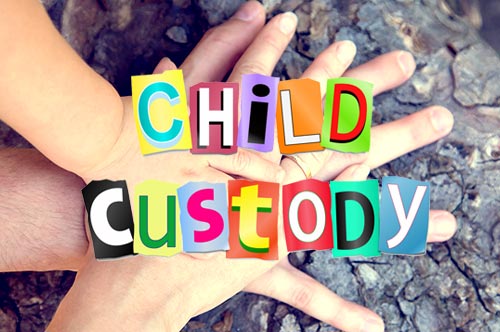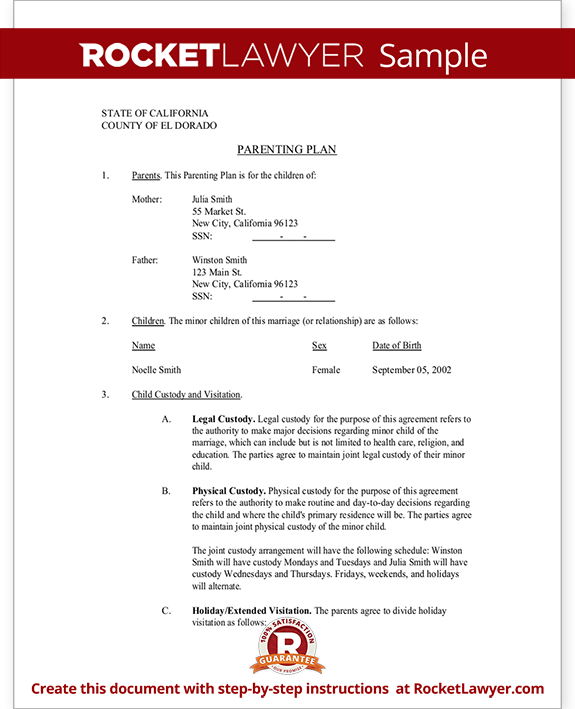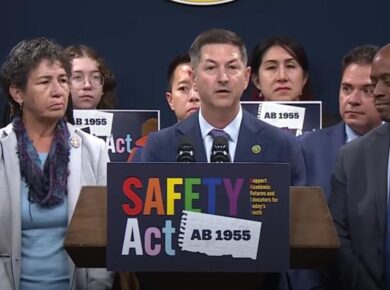The court will look at the custody, visitation, and child support clauses of your divorce agreement with the most scrutiny, because your children are more important than property or money. As parents, of course you want to look out for your children’s best interest.
Some states will distinguish between legal and physical child custody.
Legal child custody
Legal custody involves the decisions made about childrearing (the process of bringing up a child or children). These decisions might include religion, education, discipline, and the general well-being of your children. Joint legal custody gives both parents the ability to make major childrearing decisions, while sole legal custody allocates those major decisions to one parent. Usually, no matter which choice you make, the parent who is caring for the child will make basic day-to-day decisions. Each state may say different things about this, and you should look more specifically to your state’s laws.
Physical child custody
- Primary Physical Custody means that your child/children lives with you more than 50% of the time.
- Partial Physical Custody means that your child/children live with you less than 50% of the time
- Shared Physical Custody means that you have equal time with your child/children, shared equally with the other parent.
Who has physical custody will determine which parent the child will physically live with. When parents have joint physical custody, this means the child will reside with each parent for a substantial part of the year. The legal definition of joint physical custody doesn’t always have to mean a 50/50 parenting arrangement, but it varies slightly from state-to-state. It could be a certain percentage of the year (such as 35%) or a certain number of days (or overnight visits) spent with each parent. When one parent has sole physical custody, the children will live primarily with one parent, but they may have visitation with the non-custodial parent. You can decide on any visitation schedule you’d like. If you’re unable to decide, the court usually has standard visitation schedules they may go by, using different schedules for different age groups.
Experts have different opinions about whether joint or sole physical custody is best, and there are literally dozens of books written on the subject. It’s rarely denied that having both parents play an active role in a child’s life would be in the child’s best interest, provided each parent encourages the child’s social, emotional, physical, and moral well-being. However, many people feel that constantly moving back and forth between houses can be disruptive to the child’s development. Somewhere you have to find that balance that works best for your family. For some excellent articles on parenting together after your divorce, please see Divorce and Children.com.
Also Read: 5 Things To Know Before Starting a Divorce
You might find it a good idea to write out a (see the paragraph below) outlining the responsibilities and privileges each parent will have with the child. In some states, a specific parenting plan is required. The goal you should keep in mind when writing your plan is to allow for effective communication with your spouse, and encourage a close relationship between your children and their other parent. If you feel that your spouse poses a danger to your children’s health, safety, emotional, or moral well-being, then these are issues that should be addressed with a lawyer, mediator, and/or counselor. If there has been any abuse, you should seek help immediately.
Otherwise, the divorce is between you and your spouse, not your kids. Your kids aren’t divorcing your spouse, so they should be able to feel like they still can count on both parents. You should always avoid putting your kids in the middle of your relationship troubles, if at all possible. If you can minimize conflict between you and the other parent, it’s usually best for everyone.
Child Custody Worksheet
This worksheet can be used as a brainstorming sheet to help you make custody and visitation decisions for your family. One or both parents can fill it out separately, or you can both fill it out together. We can’t make the decisions for you, or even tell you what’s best, but hopefully this worksheet will get you thinking about some of the issues you’ll face that you otherwise may not have thought about. You can fill this worksheet out online or complete the printable version (a .doc file). If you filled it out by yourself, you may want to show it to your spouse or at least discuss some of the ideas you’ve come up with.
Schedules of each parent and each child:
List, in detail, each parent’s schedule, including both work and personal time. Then list the children’s schedule, including school and extracurricular activities. The purpose of this part of the worksheet is to visually be able to see the times each parent will have available to spend with the children, and compare that schedule with the needs of your children. Rather than turning custody and visitation into a “contest” with a “winner,” this will help you make a schedule that works for everyone, ultimately making your children the winners.
Mom | Dad | Children | |
Monday | |||
Tuesday | |||
Wednesday | |||
Thursday | |||
Friday | |||
Saturday | |||
Sunday |
***
Based on this schedule, what times does each parent have available
to see the children?Other issues to brainstorm:
Who will the children be with when they aren’t with either parent
(a babysitter, friend, family member)?
Is there anything about either parent’s schedule that would interfere
with caring for the children? (Would it be difficult to get time off
or leave early to care for the children? How often are you required
to work overtime? How understanding is each parent’s boss?)
If you’ve been living separate, what’s the current arrangement you
have?
What’s working with that arrangement?
What needs improvement?
Who lives closer to the children’s schools and/or daycare?
Does either parent have any plans for relocating? Explain.
Where do the children normally spend holidays, such as Christmas and
Thanksgiving?
What is each child’s relationship with each parent? Think about this
for a minute. What does each parent do for the child? What have each
parent’s responsibilities been towards the children? Is one parent the
“soccer parent,” while one is the “homework parent”?
Does one parent usually take the children shopping; is one the typical
disciplinarian? How do you see this affecting your relationship with
your children when you’re a single parent (both good and bad)?
Do the children have any special needs or interests? If so, how is
each parent equipped to care for those needs?
Do you want the children to be able to stay in the family home, if
you can afford it? Which parent would be better able to maintain the
home?
What outside support does each parent have (friends, other family members)?
How will they help with the children?
What will the overall sleeping/living arrangements be like in each
home? (ex. will the children have their own room(s), do the children
get along with each person who will be playing a major role in the parents’
lives?)
Do you want all the children to live in the same home?
Especially if considering joint custody:
How well do the two of you communicate with each other about the children?
Are you able to speak about your children without arguing every time?
Do you have plans for reducing the times you do argue?
How close do you and your spouse live to each other?
Any other comments?










